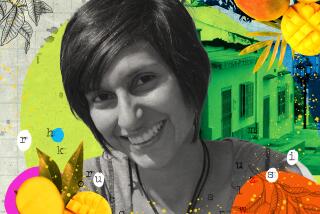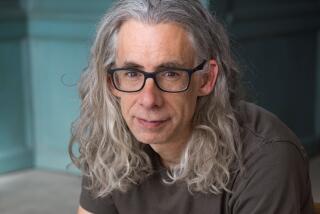Straddling the old world and the new in ‘The Farthest Home Is in an Empire of Fire’
The Farthest Home Is in an Empire of Fire
A Tejano Elegy
John Phillip Santos
Viking: 280 pp., $25.95
John Phillip Santos went in search of his Mexican father’s indigenous roots in his 1999 National Book Award finalist, “Places Left Unfinished at the Time of Creation.” That book’s solid narrative thread and magnificent storytelling rescued the forgotten history of a Tejano family. But it was only half of the story.
In “The Farthest Home Is in an Empire of Fire: A Tejano Elegy,” Santos sets out to explore his maternal ancestors’ origins in Old World Spain and their long-forgotten voyage to the New World:
“I would be born at the intersection between the bloodlines of the Mundo Viejo and the Mundo Nuevo, already well within the drift streams of the great Mexican mestizaje, the mixing of the peoples of the world that began in Nueva España.”
Santos’ mestizo blood ties become mantra: “My head was Cervantes, my body Cuauhtémoc.” His use of curanderismo, DNA testing and the Spanish Golden Age inform “Empire” as he evokes the assimilation of Mexican and Spanish culture in mid-20th century Texas.
“Los caballeros were always impeccably dressed. Dr. Ramiro Estrada, obstetrician and lawyer, the doctor who delivered us … played Chopin and Strauss on his violin, dressed in a black smoking jacket and a burgundy silk ascot. San Antonio’s modern Mexican ladies dressed like Lana Turner or Katharine Hepburn, with vaulting coiffures and hair brooches that recalled Goya’s majas or the princesas of Velasquez.”
Santos intersperses the tales with his own coming of age. He recounts a childhood steeped in literary aspirations; his adolescent infatuation with poetry and the poet Laura Riding; and his year at Oxford as the first Chicano Rhodes scholar.
When CBS News hires Santos, he describes his first day at Black Rock in Manhattitlán: “I had arrived in New York City as a curiosity, an apparently (at least) half-civilized savage from the borderlands, brown and long-haired; draped in a proper wool suit, black with red laser pinstripes and a sharply cut “pachuco” line in the jacket, baggy pants — and a fine pair of ebony Tony Lama boots that could impart the power to levitate, if that was required.”
His story is initially more compelling than his search for ancestors past — what ancestor wouldn’t be eager to learn of a future progeny’s success? — but this labyrinthine quest isn’t about his mother’s family as much as it is about finding a way to write and research that story. Santos wisely takes a more daring and imaginative what if approach to explore his forebears’ “deeper unrecorded legacy, the story they had imagined themselves to be living and telling to time.”
When he travels to the Archivo General de Indias in Seville and finds himself without proper credentials, he pleads with a librarian to Google him.
As the gatekeeper of “the official story” of Spanish exploration, the inquisitorial librarian in her manner hints as to why Santos’ relatives left the Old World without a forwarding address.
“ ‘Googlear? Tsk, tsk, tsk,’ Directora Ruiz had replied quickly, shaking her head. ‘We do not do our research on the Internet here .... This is an historical archive.’
“ ‘I’m looking for some of the documents relating to my Spanish ancestors in the far north of Nueva España. I’m Chicano, Mexican American, from Texas.’
“ ‘Chi-ca-no?’ She asked warily, writing on a notepad.
“ ‘Some spell it with an X.’
“ ‘C-h-i-x-a-n-o?’
“ ‘X-i-c-a-n-o,’ I replied.
“ ‘Que curioso.’
“ ‘I’m looking for the story of how my ancestors came out of Spain, and how they went to the tierras mas norteñas de Nueva España.’
“ ‘Is this for a historical work?’
“ ‘Yes, and cultural … y quizas un poco de ciencia-ficción, como en Don Quixote,’ I said, grinning.”
Enter the ghost of a future kinsman. Faster than reciting the magic words of Sidi Hamid Benengeli, Santos invents a Don Quixote stand-in to his own Cervantes. Cenote Siete is his time-traveling abuelo, a Carlos Castaneda-style shaman not unlike the mestizo Gaff in “Blade Runner” whose comments inform Santos’ narrative with sage advice:
“Every writer has at least two books in them — the book they write and the book that is impossible to write. In the end, it is only the impossible book that is worth writing, the one that is always out of reach for the writer: That is the book we await.”
But Cenote attempts to sabotage the narrative — first sentences, then paragraphs and chapters, and finally his own book within the book. His endless disquisitions and digressions (think Kubrick’s Jack D. Ripper or HAL 9000) spread like a virus on the author’s computer: “Did you ever wonder about those trumpets playing churrigueresco flamenco flourishes in the background of that old radio hit de los años nineteen hundred and sixties, ‘In the year 2525, if man is still alive…’? That was my idea.”
Santos’ literary genre bending — autobiography, New Age sci-fi, conquest history, time travel and magic realism — is at once wildly inventive as is his creative license, often without translation, of Spanish, Tex-Mex caló and Spanglish, but his meta-memoir’s literary pyrotechnics are ultimately more ambitious than satisfying. And yet, this adventuresome journey of dead ends and giant leaps of faith refuses to quit. In a wonderful epilogue, the type that those banal celebrity genealogical TV shows strive for, Santos does one better: The last conquistador finds his way back to Texas.
Barrios is a poet and playwright who lives in San Antonio. His play “Rancho Pancho” premiered two years ago at the Tennessee Williams Theater Festival in Provincetown, Mass.
More to Read
Sign up for our Book Club newsletter
Get the latest news, events and more from the Los Angeles Times Book Club, and help us get L.A. reading and talking.
You may occasionally receive promotional content from the Los Angeles Times.






